Key takeaways:
- Participant ownership enhances engagement, leading to deeper interactions and increased enthusiasm in workshops.
- Fostering ownership involves empowering participants through involvement in planning, creating a safe space for sharing, and encouraging collaborative projects.
- Active participation can be encouraged through personalized icebreakers, real-life scenarios, and the use of technology for anonymous feedback.
- Measuring success in participant ownership involves observing engagement shifts, follow-up actions, and constructive feedback that indicate a sense of investment in the learning process.
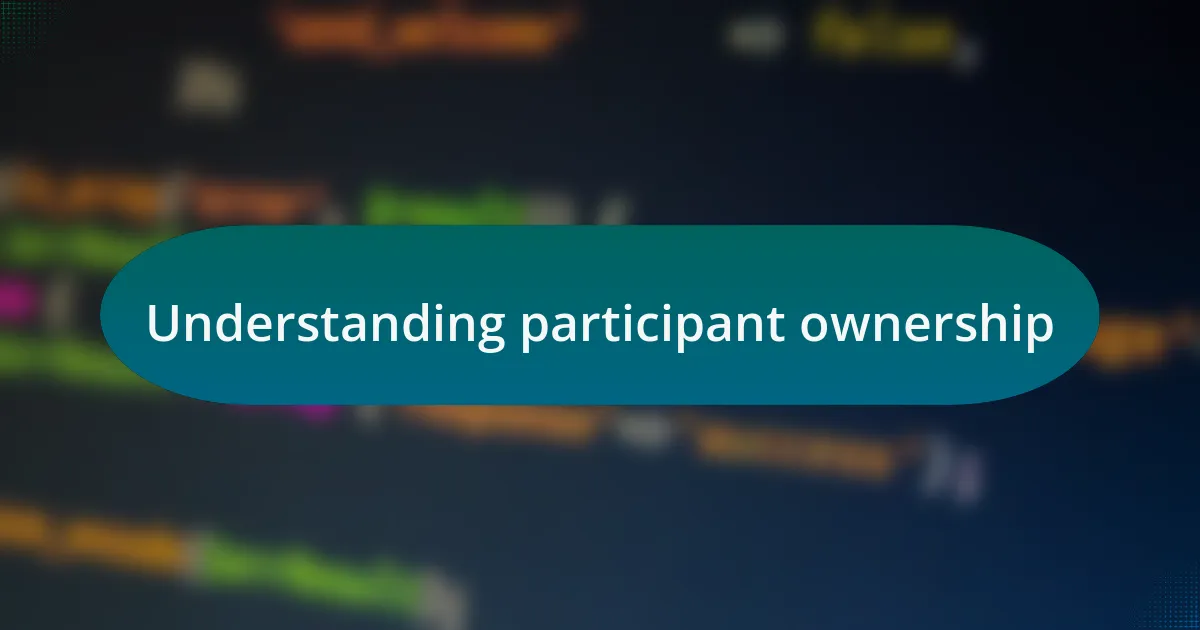
Understanding participant ownership
Participant ownership in workshops is about more than just attendance; it’s about fostering a sense of belonging and responsibility in the learning process. I vividly remember a workshop where I asked participants to share their personal stories related to the topic. The energy in the room shifted; suddenly, everyone felt invested, as if their experiences were woven into the fabric of the session. Have you ever witnessed the power of shared narratives like that? It’s truly transformative.
When participants feel a sense of ownership, they engage more deeply with the material. I noticed this firsthand during a tech workshop where attendees were encouraged to lead discussions on their projects. There was palpable excitement as individuals took the helm, sharing insights and challenges. Those moments reinforced my belief that ownership cultivates richer interactions, leading to more vibrant discussions and innovative ideas.
To me, ownership also means empowering participants to voice their opinions and shape the direction of the workshop. On one occasion, I implemented a feedback loop where participants could suggest topics for discussion in real-time. The shift was instant; not only did they show up, but they also participated actively, making the workshop a collaborative effort. Isn’t it fascinating how a little empowerment can turn passive attendees into enthusiastic contributors?
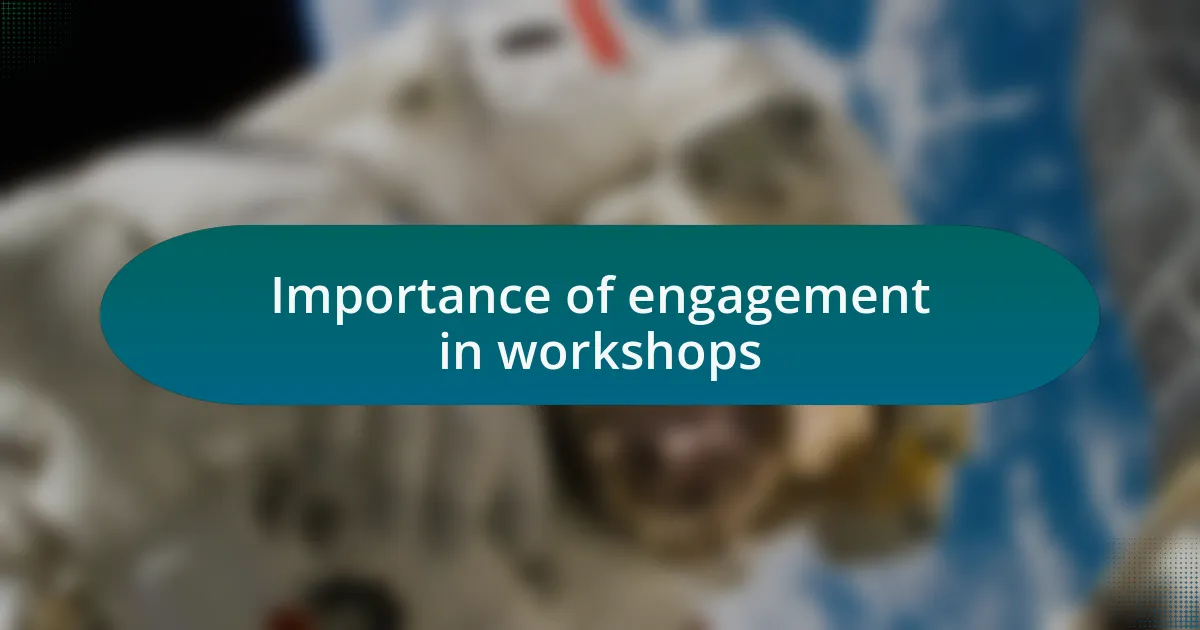
Importance of engagement in workshops
Engagement in workshops is crucial because it transforms the traditional learning environment into a lively exchange of ideas. I recall a session where participants were split into small groups to brainstorm solutions to real-world problems. The conversations bubbled with enthusiasm, and I could feel the collective energy in the room. Doesn’t it make you wonder how much more we can achieve when everyone contributes their unique perspectives?
When engagement is prioritized, the learning experience evolves, leaving a lasting impression on both the facilitator and the participants. During one of my workshops, I encouraged attendees to present their challenges and invite others to offer advice. I was amazed at how quickly they bonded over shared struggles, fostering not just learning but genuine connections. Isn’t it remarkable how engagement goes beyond content mastery to build a supportive community?
Moreover, engaged participants are more likely to implement what they’ve learned long after the workshop ends. In a recent session, I introduced hands-on activities that required participants to apply concepts immediately. I watched as some individuals eagerly took notes, ready to apply their newfound knowledge in their own projects. Have you considered how much retention improves when learning is interactive? Engaging with participants is not just beneficial; it’s essential.
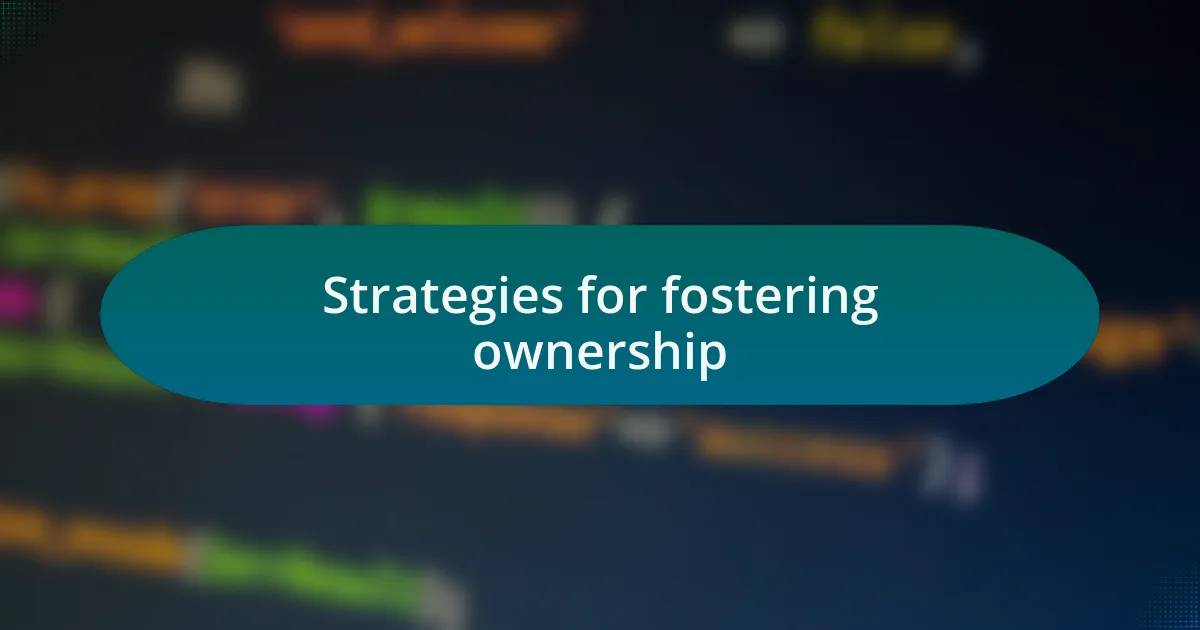
Strategies for fostering ownership
One effective strategy for fostering ownership is to involve participants in the planning process. In my experience, when I asked attendees to suggest topics or formats for the workshop, I could instantly see their investment grow. Have you ever noticed how a simple request for input can spark a sense of responsibility? It’s amazing how people feel a stronger commitment when they’ve had a hand in shaping the experience.
Creating a safe space for sharing ideas is another crucial element. During a workshop I conducted, I made it a point to celebrate every contribution—no matter how small. I remember one participant hesitating to share their thoughts, but when I acknowledged others who spoke up, they finally opened up. That moment not only boosted their confidence but also encouraged a culture of open dialogue. Isn’t it fascinating how a little validation can empower others to take ownership of their learning journey?
Additionally, integrating collaborative projects is a game-changer. I recall introducing a group challenge where attendees developed a mock tech solution together. The energy in the room shifted as they brainstormed and delegated tasks, and their sense of ownership soared. Have you thought about how active collaboration can enhance commitment to the learning process? It’s clear that when participants feel like partners in creation, their engagement skyrockets, leading to richer outcomes.
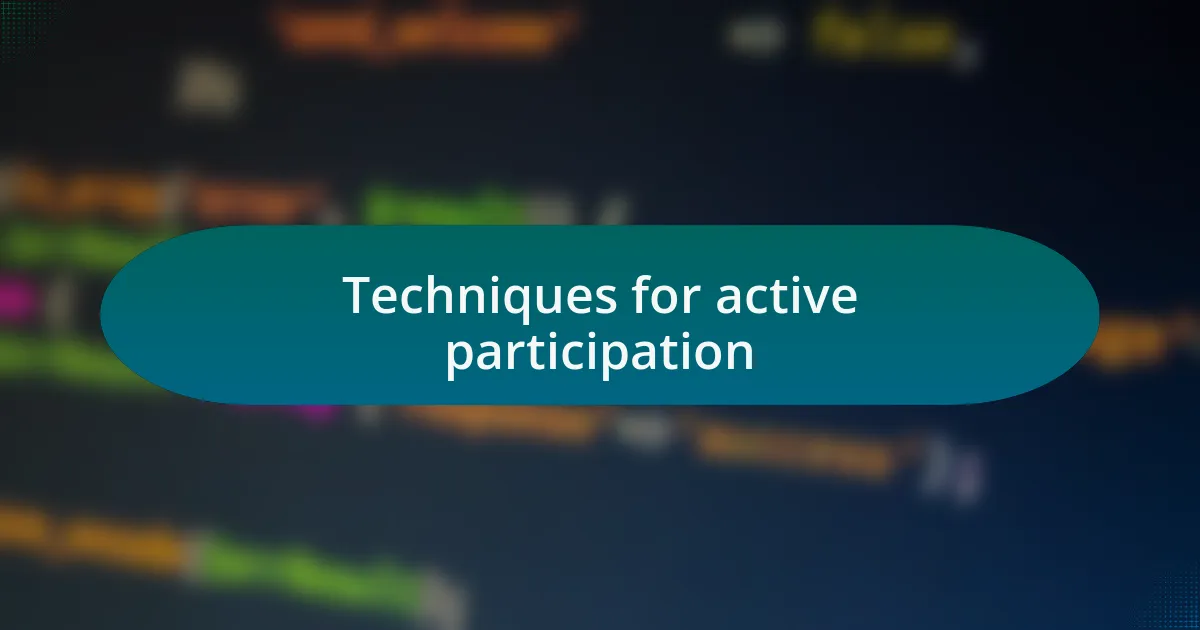
Techniques for active participation
One technique I’ve found effective in encouraging active participation is the use of icebreakers tailored to the group’s interests. During a recent workshop, I tried an activity where participants shared their tech industry “guilty pleasures.” The laughter and conversation that ensued created a relaxed atmosphere, breaking down social barriers. As we all shared our quirky favorites, I noticed a shift—people were more open to contribute afterward. Doesn’t it just make sense that when we connect on a personal level, it cultivates a greater willingness to engage?
Incorporating real-life scenarios can also elevate participation significantly. For instance, I once presented a case study based on a common industry challenge and invited attendees to problem-solve in small groups. I watched as they dove into discussions, passionately sharing their perspectives. Moments like these remind me that when participants see their own experiences reflected in the material, they become much more invested. Have you ever felt more engaged just from discussing something relevant to your daily life?
Another avenue I explore is using technology to facilitate interaction. I often utilize polling tools to gauge opinions or gather questions anonymously during sessions. Surprisingly, I’ve found that attendees who may have held back in traditional discussions feel more empowered to express themselves through these platforms. It’s intriguing how the digital space can create a comfortable distance for sharing, often leading to more profound insights. How often do you find yourself more willing to speak up when technology allows for a bit of anonymity?
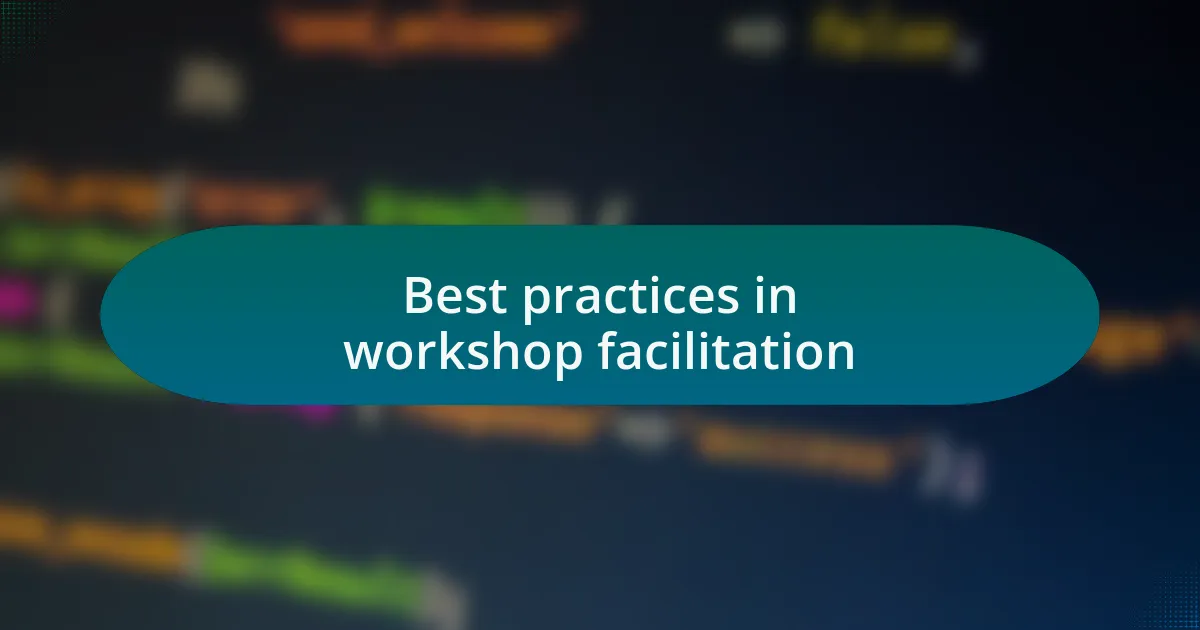
Best practices in workshop facilitation
When facilitating workshops, setting clear expectations at the outset can make all the difference. I remember leading a session where I laid out what participants could expect and what was expected of them. This clarity not only reduced anxiety but also fostered a sense of safety; participants felt free to express their thoughts without fear of judgment. Have you ever noticed how knowing the ground rules can make you more open to participating?
Utilizing varied facilitation styles is another best practice I’ve adopted. Sometimes, I switch between group discussions, individual reflections, and even role-playing exercises. I vividly recall a workshop where I used role play to simulate a challenging client scenario. The energy in the room changed dramatically as participants stepped into their roles, bringing the content to life and deepening their understanding. Isn’t it fascinating how shifting the approach can ignite engagement?
Moreover, following up on discussions after the workshop can greatly enhance participant ownership. After one particularly engaging session, I sent out a brief survey asking for feedback and insights on how they might apply what they learned. The responses showcased a newfound dedication; attendees weren’t just passive participants anymore—they were eager to implement changes in their roles. How rewarding is it to see a community take your workshop experience and turn it into action?
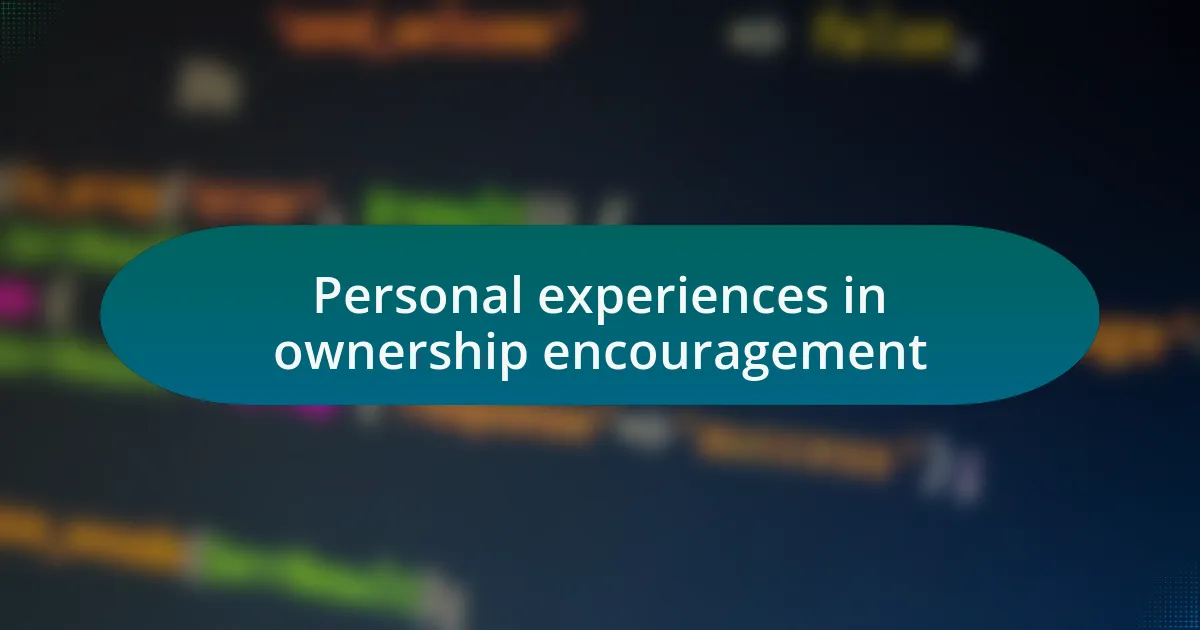
Personal experiences in ownership encouragement
One memorable experience I had was during a workshop on project management tools. I invited participants to share a project they were currently grappling with, and we brainstormed solutions as a group. Watching their eyes light up with enthusiasm as they took ownership of their challenges was truly fulfilling; it felt like I was merely a guide in their journey instead of the authority. Have you ever noticed how personal stories can transform a workshop into a shared adventure?
In another instance, I used breakout sessions to allow participants to dive deeper into specific topics. One group chose to discuss collaboration challenges, and seeing them engage passionately, debating different solutions, was electrifying. I couldn’t help but grin as one quiet attendee found her voice, advocating for a particular approach. Doesn’t it amaze you how people can surprise themselves when they’re given the floor?
I also remember a time when I incorporated a “challenge board” at the end of a workshop. Participants wrote down their commitments based on what they learned and pinned them up for everyone to see. The collective determination in the room was palpable; it was as if the air was crackling with potential. Have you ever experienced that kind of commitment in a group? It not only made the ideas tangible but also created accountability among participants, turning knowledge into action.
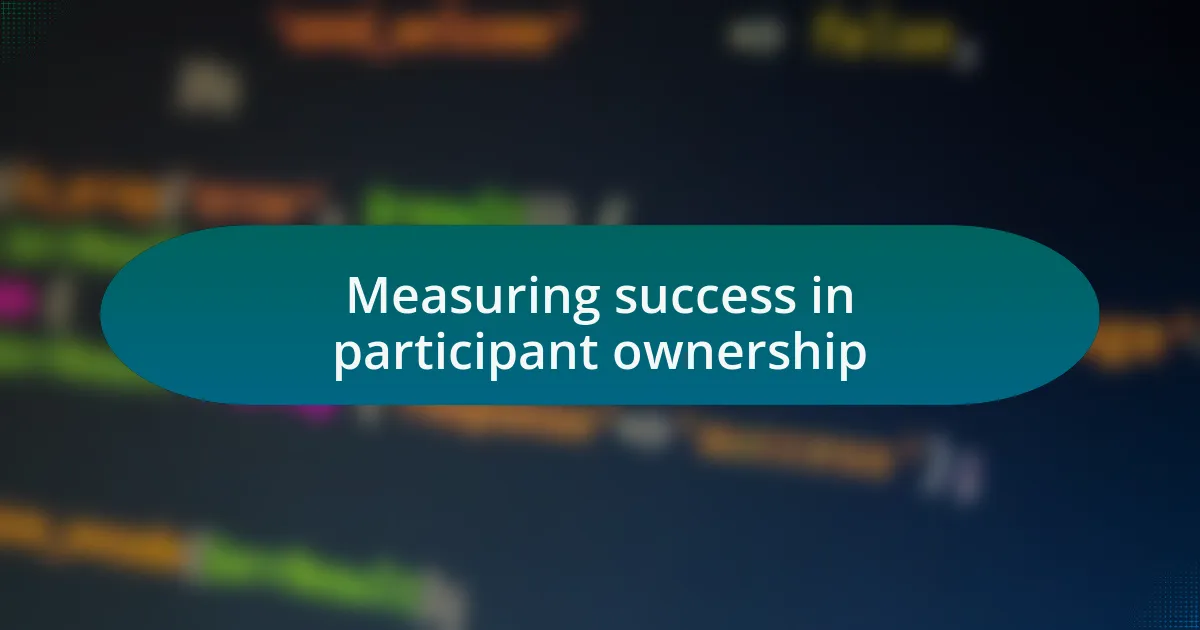
Measuring success in participant ownership
Measuring success in participant ownership goes beyond just collecting evaluations at the end of a workshop; it’s about observing the shifts in engagement and responsibility. During a recent session, I noticed that those who actively contributed to discussions often referenced their insights in follow-up conversations. It struck me that this kind of verbal acknowledgment among peers is a significant indicator of ownership—when participants feel invested, they naturally want to share their insights. Have you ever reflected on how much more impactful your workshops feel when attendees walk away not just with notes, but with a sense of pride in what they contributed?
Another strong indicator of ownership is the follow-up actions taken by participants after the event. I recall organizing a workshop where participants devised action plans based on their ideas. A few weeks later, several attendees reached out to share updates on their implementations; their excitement to inform me felt like a badge of honor. How often do we get to see the fruits of our collaborative labor? It’s incredibly rewarding when participants take the initiative to roll out the ideas we developed together.
Finally, I find that the nature of the feedback received plays a huge role in measuring ownership. In a recent workshop, participants shared not just constructive criticism, but also suggestions for future topics and activities they wanted to pursue. This willingness to shape upcoming events made me realize they didn’t just passively attend; they were co-creating the experience. Have you experienced that shift from mere audience members to enthusiastic collaborators? It signifies a deep-rooted ownership that can drive the success of any program.